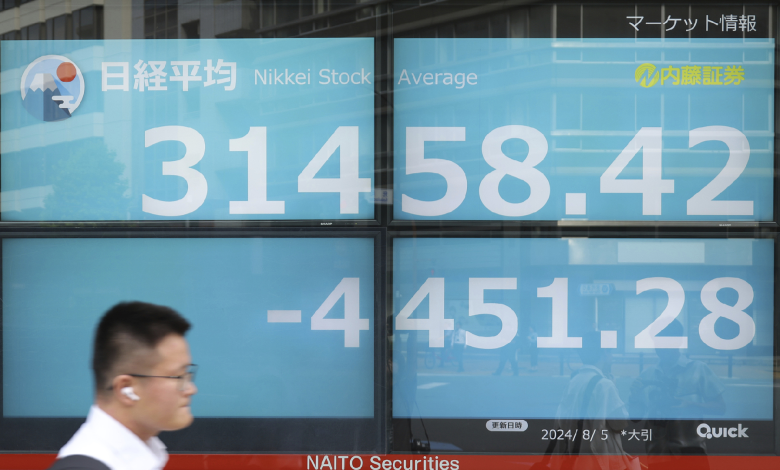What's next for USD/JPY and Nikkei 225 after the market turmoil?


Editor’s note: David Scutt is a senior market strategist at StoneX, an American financial services company. The article reflects the author’s opinion and not necessarily the views of CGTN.
It’s been a rough ride for global risk assets lately, and the turbulence shows no sign of easing at the start of this week. Investors are gripped by fears that the Federal Reserve has waited too long to pivot on its policy, especially in light of last Friday’s disappointing U.S. jobs data and a slew of other weak economic indicators pointing toward a looming recession.
<img src='https://news.cgtn.com/news/2024-08-07/What-s-next-for-USD-JPY-and-Nikkei-225-after-the-market-turmoil–1vRTpzuvoT6/img/4ed77df3463a45aa8e897a5f223581e8/4ed77df3463a45aa8e897a5f223581e8.png' alt='An electric board shows Japan's benchmark Nikkei 225 stock index plunge, Tokyo, Japan, August 5, 2024. /CFP'
JPY-based carry trade reversal
Last Wednesday (July 31) marked a day of divergent policies. The Bank of Japan (BoJ) hiked rates more than expected and the Fed signaled a cut. The BoJ surprise 15 basis points hike, relative to the 10 basis points expected, sent USD/JPY below 149 for the first time since March during its most bearish day in three months.
As U.S. stocks plunged, USD/JPY dropped by 10 percent in two weeks, exacerbating an unwind of carry trades, causing the volatility index VIX to surge above 20 percent.
In case you were wondering, carry trade is a strategy where traders borrow money at low-interest rates and invest it in higher-yielding assets. It’s a popular tactic in forex trading, where investors take advantage of low-interest rates and weaker currencies in one country to reinvest in another country with higher returns. Japan has been a favorite for carry trade, thanks to the BoJ’s ultra-loose policy that’s been in place for many years, coupled with a weak yen. This has made the yen an attractive option for global investors looking to maximize their returns through carry trades.
This unwind has been exacerbated by the yen’s recovery as the BoJ’s “detailed plan” to taper their bond purchases was not as detailed as traders have liked, but it is expected to be reduced by half to three trillion yen by Q1 2026. As the yen surged more than 10 percent against the dollar, Nikkei 225 fell an impressive 13 percent during its worst day since the Great Financial Crisis, although the index has since managed to recover 10 percent on Tuesday.
<img src='https://news.cgtn.com/news/2024-08-07/What-s-next-for-USD-JPY-and-Nikkei-225-after-the-market-turmoil–1vRTpzuvoT6/img/98e94f5ca42441aa8cf4e32782a20983/98e94f5ca42441aa8cf4e32782a20983.jpeg' alt='A pedestrian passes before a foreign exchange rate board in Tokyo, Japan, August 1, 2024. /CFP'
BoJ capitulates spectacularly
BoJ’s monetary policy holds key for the future moves. Shinichi Uchida, deputy governor of the BoJ, said on Wednesday that the bank won’t hike interest rates when markets are unstable, delivering a clear message on what traders need to do to prevent them doing so again, which is to create volatility.
It’s a capitulation of the grandest scale, undoubtedly orchestrated to restore calm to financial markets. It was only just over a week ago the BoJ hiked more than expected and provided a hawkish outlook on the monetary policy outlook.
It signals that BoJ can and will be bullied by markets to avoid doing what is right for the Japanese economy, giving traders the green light to re-establish carry trades until the BoJ starts making noise about hiking rates again, or we see a major global economic downturn.
The yen is tumbling understandably. Adding to the dovish surprise, Uchida said the BoJ must maintain the degree of monetary easing for now and suggested the BoJ would not be behind the curve if it didn’t usher through rate hikes “at pace.”
Nikkei enjoying weaker JPY again
Turning to Nikkei 225, we’ve seen an enormous snap-back after Monday’s rout, resulting in the price pushing back towards former supports that may now act as resistance at 35280, 35700 and former uptrend dating back to early 2023. The Nikkei will likely need further USD/JPY gains in the near-term to break above this zone.
Having cleared 33750 during the latest bounce, it may now act as support should we see a pullback, given it acted as strong resistance for large parts of last year. Momentum indicators are yet to provide a bullish signal, although the relative strength index (RSI) is testing the downtrend it’s been in since the early parts of July and is no longer oversold.
<img src='https://news.cgtn.com/news/2024-08-07/What-s-next-for-USD-JPY-and-Nikkei-225-after-the-market-turmoil–1vRTpzuvoT6/img/f9b2046f49e144eab176a1ff2a67f11d/f9b2046f49e144eab176a1ff2a67f11d.jpeg' alt='The Bank of Japan headquarters in Tokyo, Japan, March 19, 2024. /CFP'
Cut out noise to avoid panicking
Trust reliable market indicators for signal. In markets such as these, it pays to look at indicators that are proven signal generators over several market cycles. For me, that’s two-year U.S. Treasury notes, one of the most reliable indicators you can watch for clues on how other asset markets may fare. It’s liquid, a safe haven and it’s been leading many of the moves we’ve seen over the past week.
If risk assets are starting to look shaky again, short-end yields will tell you whether to respond on most occasions. If they decline sharply, it’s a sign risk assets may soon follow suit and tumble, and vice versus.
USD/JPY is heavily influenced by relative rate differentials. Well before riskier asset classes and USD/JPY started rolling over, two-year yield spreads between the U.S. and Japan have been compressing since May, a move at odds with USD/JPY which continued to grind higher.
If the relationship sticks, relative rate differentials between the U.S. and Japan may provide clues as to when USD/JPY and Nikkei 225 may bottom.
Short-end yields have been especially influential on USD/JPY and Nikkei 225 over the past month, sitting with scores of 0.95 and 0.93 respectively on a daily timeframe. For example, on Tuesday, two-year UST yields rose by nearly 35 basis points from the lows on Monday, coinciding with Nikkei 225 and yen’s reversals of Monday’s moves.


 Bonus up to 10000 Rupees
Bonus up to 10000 Rupees